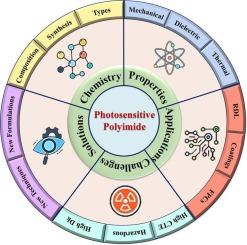Recent progress and challenges of photosensitive polyimides in advanced packaging: Technology beyond limit
IF 6.3
2区 化学
Q1 POLYMER SCIENCE
引用次数: 0
Abstract
With the advancements in technology, the continuation of Moore’s law has become increasingly challenging. Consequently, heterogeneous integration (HI) and advanced packaging have emerged as critical focal points within the microelectronics industry. However, to mitigate the power dissipation and noise in interconnects, these advanced packaging systems require materials with low dielectric constants. Photosensitive polyimide (PSPI) is one such high-performance material emerging as a suitable candidate for advanced packaging applications due to its exceptional thermal, mechanical, and electrical insulation properties. In this review, we provide a detailed analysis of PSPIs particularly chemistry, formulations, working mechanism and properties essential for advanced packaging. Some recent advancements in PSPIs are reviewed along with a discussion of their key applications in advanced packaging. Finally, current challenges of PSPIs are briefly addressed with possible solutions and future prospects. This review article is potentially beneficial for future research and development in advanced packaging and HI processing.

先进封装中光敏聚酰亚胺的最新进展和挑战:技术超越极限
随着技术的进步,摩尔定律的延续变得越来越具有挑战性。因此,异构集成(HI)和先进封装已经成为微电子工业的关键焦点。然而,为了减轻互连中的功耗和噪声,这些先进的封装系统需要具有低介电常数的材料。光敏聚酰亚胺(PSPI)是一种高性能材料,由于其卓越的热、机械和电绝缘性能,成为先进包装应用的合适候选者。本文对pspi的化学、配方、工作机理和性能进行了详细的分析。评述了pspi的一些最新进展,并讨论了它们在先进封装中的关键应用。最后,简要介绍了pspi当前面临的挑战,并提出了可能的解决方案和未来前景。本文对未来先进包装和HI加工的研究与开发具有一定的参考价值。
本文章由计算机程序翻译,如有差异,请以英文原文为准。
求助全文
约1分钟内获得全文
求助全文
来源期刊

European Polymer Journal
化学-高分子科学
CiteScore
9.90
自引率
10.00%
发文量
691
审稿时长
23 days
期刊介绍:
European Polymer Journal is dedicated to publishing work on fundamental and applied polymer chemistry and macromolecular materials. The journal covers all aspects of polymer synthesis, including polymerization mechanisms and chemical functional transformations, with a focus on novel polymers and the relationships between molecular structure and polymer properties. In addition, we welcome submissions on bio-based or renewable polymers, stimuli-responsive systems and polymer bio-hybrids. European Polymer Journal also publishes research on the biomedical application of polymers, including drug delivery and regenerative medicine. The main scope is covered but not limited to the following core research areas:
Polymer synthesis and functionalization
• Novel synthetic routes for polymerization, functional modification, controlled/living polymerization and precision polymers.
Stimuli-responsive polymers
• Including shape memory and self-healing polymers.
Supramolecular polymers and self-assembly
• Molecular recognition and higher order polymer structures.
Renewable and sustainable polymers
• Bio-based, biodegradable and anti-microbial polymers and polymeric bio-nanocomposites.
Polymers at interfaces and surfaces
• Chemistry and engineering of surfaces with biological relevance, including patterning, antifouling polymers and polymers for membrane applications.
Biomedical applications and nanomedicine
• Polymers for regenerative medicine, drug delivery molecular release and gene therapy
The scope of European Polymer Journal no longer includes Polymer Physics.
 求助内容:
求助内容: 应助结果提醒方式:
应助结果提醒方式:


